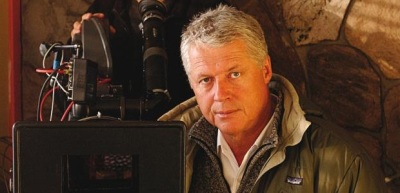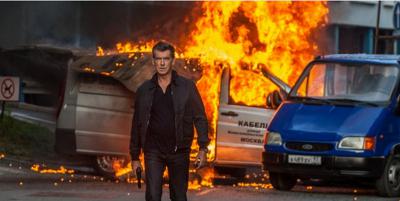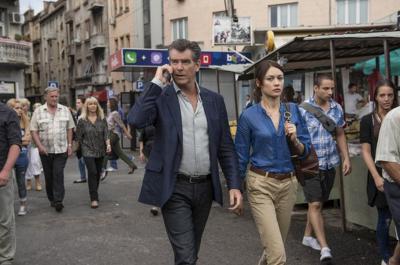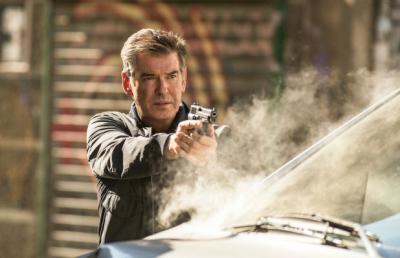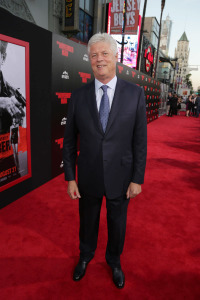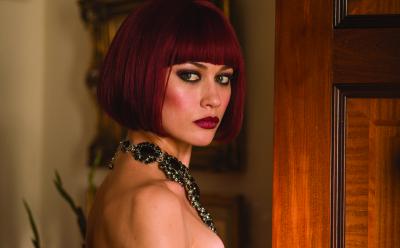By: debbie lynn elias
Roger Donaldson has long been adding his own distinctive directorial brush strokes to the cinematic canvas. With “No Way Out”, he crafted an indelible palette of politics, murder, corruption and fear, giving us just an inkling of what lie ahead for then still relative newcomer, Kevin Costner. “Cocktail” made us fall in love all over again with beaches, big city, bartenders, big dreams, Tom Cruise and the Beach Boys while Donaldson sold us on funny man Robin Williams as car salesman Joey O’Brien in “Cadillac Man.” A dramatization of the Cuban missile crisis had us riveted to the screen with “Thirteen Days” as Donaldson re-teamed with now superstar, Kevin Costner. As writer and director, Donaldson created an engrossing portrait of New Zealander Burt Munro and his 1920 Indian motorcycle with “The World’s Fastest Indian”. In “Dante’s Peak” we were treated to not only some fantastic lensing and effects, but an immersive palpable experience with volcanic devastation – and Pierce Brosnan – at “Dante’s Peak”. And now, Donaldson and Brosnan join forces again with “The November Man”. Bringing a seasoned meld of action and psychological intrigue that only comes with experience and maturity, Donaldson ups the ante with this riveting edge of your seat thriller that gives new meaning to the term “Russian Roulette”.
As Donaldson and I strolled down his cinematic memory lane for this exclusive interview, he vividly recalled the experience of making “Dante’s Peak.” Of course, he was equally amazed at my having seen the film at least 200 times. “Thank you for seeing ‘Dante’s Peak’ 200 times! I enjoy watching it, too.” Agreeing there’s just something addictive about the film, Donaldson sums it up nicely. “It’s called ‘Grandma sacrifices herself there’ [laughing] . . . We had so much fun making that movie. Both just because we were all together up in the wilds of Idaho in this little town, so we were all thrown together. But just the scale…that scale of moviemaking is gone. . .The thing is, is that everything’s real. It’s all real.” That scale of moviemaking and the practical nature of the filming, stunts and action is something that Donaldson brought to “The November Man” as well, proudly stating, “Most of it’s real in ‘November Man’, too.”
But it’s talking about leading man Pierce Brosnan when Donaldson’s eyes twinkle even a bit brighter. “I loved ‘The Matador’. He was good in it! And then, he’s done great stuff like ‘Mrs. Doubtfire’ and ‘Mamma Mia’.”
Not to be overlooked, Donaldson is equally effusive when talking about reteaming with Will Patton and Bill Smitrovich and what makes him want to keep working with all of these guys. “I’m a great fan of [the idea] if you find somebody who really can deliver the work and got the chops and you’ve got an opportunity to see an old friend, you’re like, ‘Come on.’ You know? I mean Bill, he’s such a fun guy. He loves acting. He loves movies. . .It’s just great to see him and he’s good. So, when you can have an excuse to drop around to have a cup of tea with an old friend, that’s what you do.”
Known best for his work on films like “Taken 2″ and “The Transporter 3″, cinematographer Romain Lacourbas is now referred to as “the greatest” by Roger Donaldson. Recalling the search that led him to the perfect man for the job of “The November Man”, Donaldson animatedly talks about Lacourbas. “I looked at a lot of DP’s [Director of Photography] work and Romain felt like he had the chops and the look that I was looking for – that really classy, European sort of look. But one that I felt would translate to American audiences as well. And he was good. Young, French and energetic.” Creating a beautiful tonal bandwidth with the natural and practical light of the film, even Donaldson admits, “It’s got a great look.” By creating a visual tone that is lighter than the psychological tones of the story, there is a great juxtaposition of lightness versus heaviness.
Key to the visual appeal and tone of “The November Man” is shooting in Belgrade. With so many untapped locations that the western audiences haven’t seen in films, Belgrade was a playground for Donaldson and his team. “That was what appealed to me about [Belgrade]. . . I had no idea what the city even looked like until I went there. I’ve never seen it in a movie, so it felt like there was some[thing fresh]. You’re always looking to try and find and work with a new place, a new location, new look. So, it made that part of it a lot easier.”
Logistically, Belgrade was very freeing when it came to shooting. “There were a lot of things you wouldn’t be able to do anywhere else. . . we wanted to do a car chase through the real traffic. [laughing] And not tell anybody! We’ll just do it. And we’ll get Pierce driving the car. Pierce is a really good driver, but a car covered in cameras. . .” But it worked.
For capturing all of the action in “The November Man”, “We had three main cameras and if we had action sequences, we would have all of them, supplemental ones, you know. Everything from GoPros to D5s and stuff like that.” Shooting digitally but with anamorphic lenses to get that widescreen, filmic texture, Donaldson credits “this other DP friend of mine, Andrzej Bartkowiak, who did ‘Dante’s Peak”. A great buddy of mine.” who introduced him to the German lensmakers, Advantage Films. Advantage “build anamorphic lenses and sort of recreate the old imperfections. . .put a patina on the image somehow that really helps the digital images look not quite so brittle but more filmic.” Quick to admit his love of digital and that “I’m not out there trying to make it look like it’s film”, in certain films, as here, shooting anamorphically takes the edge off, buffering the imagery like a fine wine, “so you don’t see every pore.” Also significant is that “Romain [Lacourbas] was, as I am, a great fan of getting the lens flare and stuff like that, you know, so lots of light coming into the lens. It just makes it like a movie.”
A new aspect to filmmaking with “The November Man” is not just the use of low-flying drones in front of the camera (we saw it as major plot point in a tv episode of “Castle”), but behind it. Drones are used openly within the espionage context of the story providing surveillance video feeds to the characters. But Donaldson went a step further. “Drone footage is filmed from the drone. . .Not the one necessarily that was in the shot at the same time as we’re shooting, but [the same perspective].” Interestingly, with all the public concerns over surveillance and drones being hot topics of conversation, there were no issues about using drones and shooting footage with drones. The problem came with Donaldson wanting to get exterior footage of the new U.S. embassy in Belgrade. “It’s giant. . .I wanted to get some exteriors of this and we couldn’t get permission for this. It’s the only thing we couldn’t make happen. We could’ve stolen it, but I didn’t need that sort of aggravation. [laughing]”
Beyond pleased at how great the film looks in terms of its scope and in being cinematic, something all could appreciate at the film’s premiere at the TCL Chinese Theatre, sound is always important to Roger Donaldson and he was beyond pleased with the visual and sound capabilities at the Chinese since its renovations. “It looked great…it sounded great. . . That was as good of a premiere as I’ve ever had!”
So often with action films when there are explosions, car chases, not to mention everyday ambient noise thrown in the mix, quality of sound when it comes to dialogue is sometimes sacrificed and lost to the audience. Not so with a Roger Donaldson film. “I run the whole movie just listening to it. . . It’s interesting how you, when you’re watching stuff, you think you understood it. But if you’re just listening to it, you perceive it differently. So, I’m very critical in making sure the dialogue can be understood.” With “The November Man” we hear everything, right down to the click of Olga Kurylenko’s stiletto heels on tile or a pen being tapped on a table.
While Pierce Brosnan and his producing partner Beau St. Clair jumped into “The November Man” back in 2005 as Brosnan was bidding adieu to Bond and St. Clair stumbled onto Bill Granger’s spy thriller, “There Are No Spies” in the 13 volume November Man series, Donaldson joined the game about two years ago. It was impossible not to get his views on what takes a film like this so long to get made. “I think the challenges these days are just the financial side of the business. It’s tough. Getting all the ducks in a row. Getting an independent movie, getting a big release like this, is just about unheard of these days. So, that itself, is no mean feat. And just getting distribution!”
With that in mind, would Donaldson consider a crowdfunding campaign like IndieGogo or Kickstarter for a project he is currently working on? “ I would do anything to get this movie made.” With “possibly another ten” ideas ruminating for future films, dear to his heart is a project that is very personal. “I’ve written a script. It’s a very different sort of movie. It’s an adult family about a father and daughter doing a road trip across America. It’s written by me and my daughter, inspired by me driving her to college. She went to Vassar college ten years ago and I drove her there. It was a great experience. . .[the script] is a story built around the sort of experience on the road trip and what happens on the way and what happens to the people. So, we wrote a script and we’ve nearly finished it. It’ll be hard to get made, but that’s one of them. Then, there’s another ten. [laughing]”
After all these years and all the accolades and all the great cinematic gifts that Roger Donaldson has given us, including “The November Man”, what has filmmaking given him? “I love the creativity. I love working with other people. You know, you don’t do it on your own. It’s not lonely. It’s not sort of sitting in a dark room or it’s not like writing; it’s hard because you’re doing it on your own. But with filmmaking you’re having to work with a lot of people and I get to be the leader of the pack. You’ve got a lot of very talented people around you that you get a lot out of, as well. So, there’s a sort of camaraderie, I suppose, about filmmaking and it’s creative. And you get to tell stories.”

